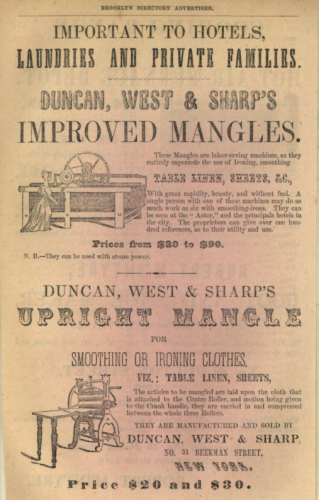Funny Friday: Did the Springsteens use a ‘mangle’?

Springsteen Family (Click for Family Tree)
It must have been one of those days, or I had been researching waaaaay too long (probably the latter). Seeing this ad while I was searching page by page for Springsteen ancestors in the 1857 Brooklyn City Directory, it just hit me funny. A ‘mangle’??
Even though I read old books and history and love archaic terms, I had never heard of a mangle before. This certainly looked like one could get a hand or long hair ‘mangled’ in it, and I knew that was true because my grandmother had a wringer washer and we kids played with it when she wasn’t looking. I had long hair and, well, we won’t go there…
I had never seen a wringer with a table attached though, nor one so large, so time for some research.
Wikipedia to the rescue, which is hard for me to say, but I have found it is more accurate than I used to give it credit. Wikipedia says the machines are called ‘mangles’ in the UK, but ‘wringers’ here in the US. Looks like they were called ‘mangles’ here for some time too- the British influence on our country was strong.
The earliest and most simple mangle was a cylinder that was wrapped with a wet cloth that had just been laundered, like a tablecloth or sheet, and rolled with a flat board pressed along the top to get the excess water out before line drying, or to remove wrinkles. (Our colonial ancestors probably used one.) The wringer for a washer was invented in the 1840s, , which would have saved women a lot of time. A wringer would have really helped in the winter, too, when clothing and household items had to be hung indoors because of inclement weather- getting most of the water out before hanging meant your head would not be dripped on while eating dinner, sewing, etc.
Heat was later added to the cylinders to help dry and press cloth. My mother and grandmother both had mangles, though we called them ‘ironers.’ They are large machines that put off a lot of steam and heat. A foot pedal or knee lift raised or lowered one of the rollers so that you could put a piece of cloth in, then lower the cylinder and iron away. My mother was SO good at using hers- she could iron a man’s shirt or pants with it! Really fast, too.
Mangles are not really used anymore except in commercial applications, such as hotels that dry and press their long tablecloths on them. Smaller mangles, such as those of my mother and grandmother, can be seen today in smaller laundries like the neighborhood dry cleaners.
Sure seems like the above mangle would have taken up a lot of room, even the smaller one. The table likely folded up, but that would still be a lot of space required. I wonder if Jefferson and Anna (Connor) Springsteen had a ‘mangle’ in their house in 1850s Brooklyn?
Notes, Sources, and References:
- Wikipedia: Mangle- https://en.wikipedia.org/wiki/Mangle_(machine)
Please contact us if you would like higher resolution images. Click to enlarge images.
We would love to read your thoughts and comments about this post (see form below), and thank you for your time! All comments are moderated, however, due to the high intelligence and persistence of spammers/hackers who really should be putting their smarts to use for the public good instead of spamming our little blog.